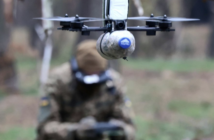Welcome to the CavasShips Podcast with Christopher P. Cavas and Chris Servello…a weekly podcast looking at naval and maritime events and issues of the day – in the US, across the seas and around the world. This week…Accurately analyzing the US Navy’s spending habits is a daunting task, but we hear from perhaps the primary practitioner of that art, Dr. Eric Labs of the Congressional Budget Office, who breaks it down for us.
Please send us feedback by DM’ing @CavasShips or @CSSProvision or you can email chriscavas@gmail.com or cservello@defaeroreport.com.
This Week’s Naval Round Up:
The Chinese Balloon continued to dominate defense discussions this week, even as the US Navy and Coast Guard teamed up to recover debris from the downed balloon off the coast of Myrtle Beach, South Carolina. The amphibious ship CARTER HALL took station near the debris field within a day or so after the balloon was shot down on Feb. 4 by an F-22 Raptor fighter. CARTER HALL was joined briefly by the cruiser PHILIPPINE SEA and destroyer OSCAR AUSTIN but the warship left by February 6. The Navy survey ship USNS PATHFINDER mapped the ocean bottom around the crash site as sailors from Explosive Ordnance Disposal Group 2 carried initial recovery of the balloon’s wreckage. With the Coast Guard providing security, the chartered vessel HOS ROSEBUD arrived on the scene late February 9 to take aboard any larger pieces of debris. With the HOS ROSEBUD’s arrival, CARTER HALL left the operation.
The Russian news agency Tass reported on February 7 that the last Project 941 Typhoon-class ballistic missile submarine, the DMITRY DONSKOY, has been decommissioned. DONSKOY was also the oldest of the six Typhoons placed in service, having been commissioned in 1981 and more recently modified for use as the test ship for the new Bulava-M ballistic missile installed on next-generation Project 995 Borey-class submarines. The Typhoon submarines, known by the Russian Navy as the Akula class, are the largest submarines ever built, displacing 23,200 tons on the surface and 30,460 tons submerged. They were powered by two reactors and featured a unique design that had two side-by-side pressure hulls with the 20 missile launch tubes placed between the them. The submarine were made famous by the novel and movie Hunt For Red October, starring the fictional Typhoon-class submarine of that name.
A ceremony was held February 9 at BAE’s shipyard at Barrow-in-Furness, England to mark the start of fabrication of the nuclear submarine WARSPITE, the third ship in the new Dreadnought class of ballistic missile submarines. Two other submarines in the class, Dreadnought and Valiant, already are under construction.
In France, the assault ship DIXMUDE and frigate LA FAYETTE left Toulon February 8 to begin the French Navy’s annual Jeanne D’Arc round-the-world training cruise. The ships are expected to return to Toulon in July. And the French carrier CHARLES DE GAULLE, which has been operating in the Indian Ocean region since just before Christmas, was reported to be passing northbound through the Suez Canal on February 10 in the last stages of her Operation Clemenceau strike group deployment.
In Latin America, Brasil scuttled the decommissioned aircraft carrier SAO PAULO February 3 off the Brazilian coast in water more than 16,000 feet deep. While environmentalists decried the ship’s sinking, the SAO PAULO was reportedly full of asbestos and no country was willing to let it dock for the asbestos to be removed.
Cavas Squawk:
We’ve just been hearing from one of the most important observers in Washington on how the US Navy goes about some of its most important business – spending money to buy the ships, aircraft, weapons and systems it needs to safeguard the nation’s security. Eric Labs at the Congressional Budget Office and his compatriot Ron O’Rourke at the Congressional Research Service have well over a half century of experience in watching and analyzing the Navy’s ability to forecast, budget for and deliver its weapons. They have accumulated a wealth of knowledge and experience that comes from having done the job year in and year out.
Eric and Ron’s influence on Congress and the Navy cannot be overstated, not when there is a constant shuffle and turnover of senators and representatives, committee assignments and parties. Not when administrations change at least every four years and at most every eight years. Not when service secretaries, service chiefs, and service budget directors rotate in and out of office. Not when the Pentagon’s leadership does the same.
And speaking for my side of the equation, reporters, journalists and editors themselves come and go, with widely varying degrees of ability and knowledge.
That of course is the nature of a democracy and a representative government, and it is well and good. But it also produces a churn where sometimes those driving a conversation either just found out about something that others have been dealing with for years, or when a political approach can turn things inside out.
It’s in those times that the steady analysis coming from CBO and CRS and several other entities becomes ever more important. They’re a constant in the constantly rotating personalities of the government. And in this case, Eric and Ron are some of the best who have ever had that responsibility.
Whether Congress, the Navy, the Pentagon, the administration or the public heed the information Labs and O’Rourke provide is a different topic. And in an era where it’s fashionable to constantly complain about government, it’s often overlooked that the Labs and O’Rourke service of analysis and support is a part of government that is not only valuable, but it works really well.




